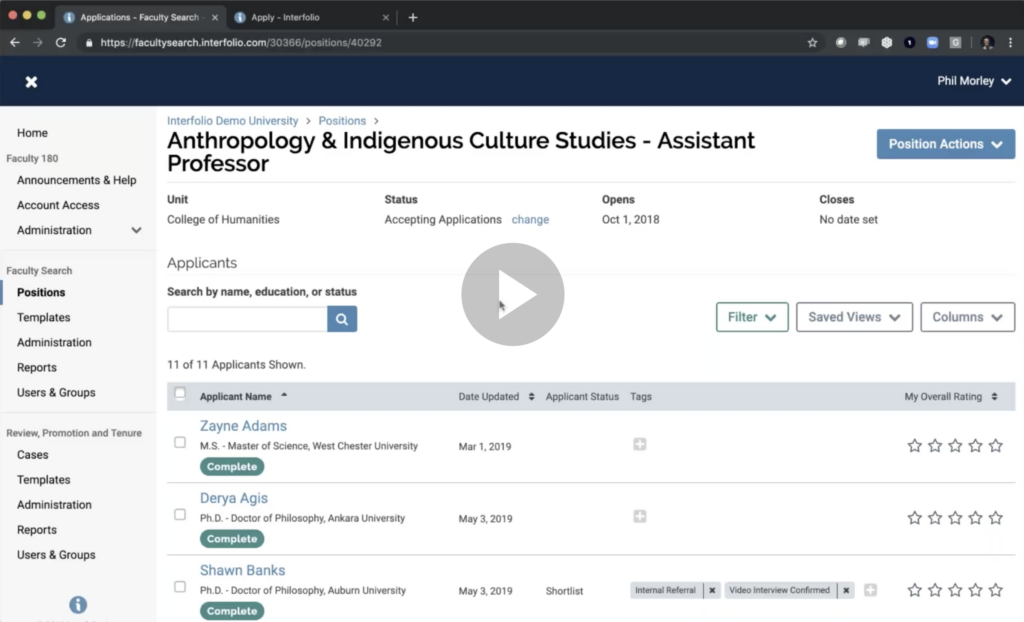The University of Florida will launch Interfolio’s faculty hiring module, Faculty Search, at the beginning of this academic year to support the university’s “Faculty 500” initiative to hire 500 new faculty members over two years—200 of those by this fall. Two leaders from UF’s Human Resources office, Melissa Curry, Director of Recruitment and Staffing, and Kathy McKee, Manager of Strategic Talent Group, joined us recently for a webinar addressing UF’s distinctive faculty hiring strategies and about the role Interfolio will play.
Many leading institutions use Interfolio for faculty hiring alongside common HR and ERP systems—some even integrating them together. Curious how we could help you streamline faculty hiring? Let us know today.
Challenges involved in an institution-wide hiring initiative
The commitments involved in the Faculty 500 initiative posed significant logistical challenges for all involved in faculty hiring at UF—not least the HR office. Competition for top faculty members was fierce. No new administrative resources would be allocated, and UF’s HR office had a very short time period before hiring processes would begin. In addition, hiring faculty takes place in a decentralized environment, and within a culture of shared governance and search committees—all factors that tend to lengthen the hiring process.
Responding with a strategic recruitment model
In response to the challenging landscape, UF made a commitment to transition from their traditional faculty hiring approach to a more strategic recruitment model. Fundamental to the change was the realization that faculty hiring was simply a unique process, different from hiring staff, administrators, and other personnel. As Melissa and Kathy present in thoughtful detail in the webinar, the new approach would require new commitments, processes, and technologies. It took the form of a plan with five distinct elements, or stages. (Find Melissa and Kathy’s prepared presentation on those stages in the webinar recording.)
Q&A highlights
In addition to Melissa and Kathy’s great detailed presentation about their faculty recruitment strategy as a whole, we posed a few questions about how the institution’s transition to Interfolio fits in.
Please note: These responses have been edited slightly for clarity and length.
Question 1: Did you have any technology you were already using for faculty hiring?
For us, the issue with most applicant tracking systems is they are designed for companies and not designed for institutions of higher education that have a shared governance model. We even find that difference between faculty and public employers because the shared governance model is so different at institutions of higher education. Even though our regular applicant tracking system faculty could post online, which was definitely was easier than the paper process, there was an administrative burden because applicant tracking systems are developed for private companies, which generally are very centralized and do not have shared governance.
One of the things that attracted us to Interfolio was the platform was developed for institutions of higher education with faculty search, search committees, and shared governance in mind. We didn’t really find that anywhere else. The ease for the search committee, from an electronic process that looks and acts like the paper process they’re used to, was very attractive.
We had an electronic system but most committees were printing the submitted 200 CVs (which totaled hundreds of thousands of pages) so even though it was an electronic system applications were not easy to read online.
Question 2: What aspects of the faculty hiring experience specifically merited adopting a better technology for it?
We didn’t have in mind that we needed a new system or an additional system. But what we were hearing was there were specific pain points. When Interfolio came to our attention, we started asking questions.
The ads postings actually look different for faculty positions versus staff positions. Allowing them greater flexibility in how they would appear and how they would be seen online was something Interfolio offered that our current system didn’t have. The whole interactivity: allowing blind review, and allowing search committees and evaluators to make comments on applicant packets (similar to what they might do on written materials)—these were the things our current system doesn’t allow, so those were very important.
Many of our departments were having this issue, which was raised by deans, of collecting reference letters. In the traditional module, you have people submitting for faculty positions, then the department requests from the applicant to have the referee submit their letters directly to the hiring department. Our existing applicant tracking system ended up shifting that traditional burden to the hiring departments, so they were sending notices out to the referees. Then, there could be communication glitches, which created these circles with respect to recommendation letters. With [Interfolio’s], the fact that applicants and referees are familiar with the dossier service and it’s integrated with Faculty Search, that was a great assist for us that came as a part of what Interfolio is.
Interfolio also presents an opportunity to use a tool that seems very straightforward, that on its face is similar to what they were doing traditionally in the academy, and not making them adopt different types of behavior because they’re using an electronic system.
Question 3: What impact do you predict the new academic hiring experience will have on UF’s ability to meet its goals?
For us, the immediate goal that we think Interfolio is going to help with is hiring of an additional 300 new faculty members in the next 12 months. Some of the things we’re looking for from Interfolio are things like ease of use for search committee members. These faculty members are changing the world—what they do matters. We have some of the best and brightest faculty members in the world, and we want them to do that, and not be burdened with administrative tasks just because they want to participate in the search committee to hire a colleague. And we believe Interfolio will help them quickly participate and give meaningful feedback to hiring the best and the brightest, and then to go back to their business of changing the world.
***
Is there room for improvement in faculty recruitment at your institution? Interested to see a demo of the faculty-friendly Interfolio hiring platform? We’re happy to help. Contact us today with the form below.
Ready for your Faculty Information System?
Contact us today to understand how Interfolio’s scholar-centric technology addresses the needs of higher education and research funders.
Already a customer and need support-related help? Email us at help@interfolio.com.












